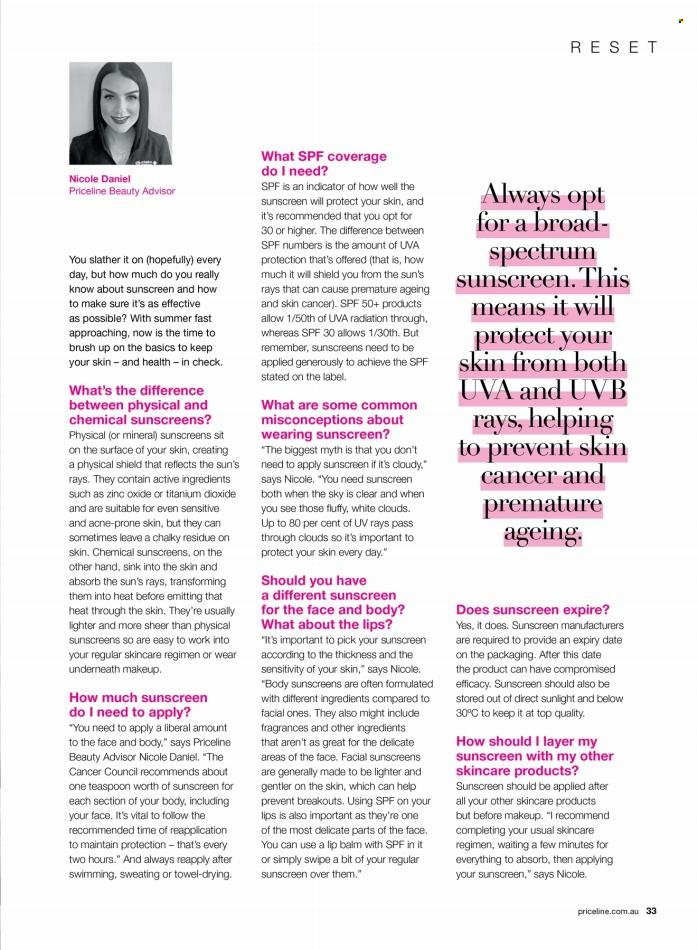Nicole Daniel
Priceline Beauty Advisor
You slather it on (hopefully) every
day, but how much do you really
know about sunscreen and how
to make sure it's as effective
as possible? With summer fast
approaching, now is the time to
brush up on the basics to keep
your skin - and health - in check.
What's the difference
between physical and
chemical sunscreens?
Physical (or mineral) sunscreens sit
on the surface of your skin, creating
a physical shield that reflects the sun's
rays. They contain active ingredients
such as zinc oxide or titanium dioxide
and are suitable for even sensitive
and acne-prone skin, but they can
sometimes leave a chalky residue on
skin. Chemical sunscreens, on the
other hand, sink into the skin and
absorb the sun's rays, transforming
them into heat before emitting that
heat through the skin. They're usually
lighter and more sheer than physical
sunscreens so are easy to work into
your regular skincare regimen or wear
underneath makeup.
How much sunscreen
do I need to apply?
"You need to apply a liberal amount
to the face and body," says Priceline
Beauty Advisor Nicole Daniel. "The
Cancer Council recommends about
one teaspoon worth of sunscreen for
each section of your body, including
your face. It's vital to follow the
recommended time of reapplication
to maintain protection - that's every
two hours." And always reapply after
swimming, sweating or towel-drying.
What SPF coverage
do I need?
SPF is an indicator of how well the
sunscreen will protect your skin, and
it's recommended that you opt for
30 or higher. The difference between
SPF numbers is the amount of UVA
protection that's offered (that is, how
much it will shield you from the sun's
rays that can cause premature ageing
and skin cancer). SPF 50+ products
allow 1/50th of UVA radiation through,
whereas SPF 30 allows 1/30th. But
remember, sunscreens need to be
applied generously to achieve the SPF
stated on the label.
What are some common
misconceptions about
wearing sunscreen?
"The biggest myth is that you don't
need to apply sunscreen if it's cloudy."
says Nicole. "You need sunscreen
both when the sky is clear and when
you see those fluffy, white clouds.
Up to 80 per cent of UV rays pass
through clouds so it's important to
protect your skin every day."
Should you have
a different sunscreen
for the face and body?
What about the lips?
"It's important to pick your sunscreen
according to the thickness and the
sensitivity of your skin," says Nicole.
"Body sunscreens are often formulated
with different ingredients compared to
facial ones. They also might include
fragrances and other ingredients
that aren't as great for the delicate
areas of the face. Facial sunscreens
are generally made to be lighter and
gentler on the skin, which can help
prevent breakouts. Using SPF on your
lips is also important as they're one
of the most delicate parts of the face.
You can use a lip balm with SPF in it
or simply swipe a bit of your regular
sunscreen over them."
RESET
Always opt
for a broad-
spectrum
sunscreen. This
means it will
protect your
skin from both
UVA and UVB
rays, helping
to prevent skin
cancer and
premature
ageing.
Does sunscreen expire?
Yes, it does. Sunscreen manufacturers
are required to provide an expiry date
on the packaging. After this date
the product can have compromised
efficacy. Sunscreen should also be
stored out of direct sunlight and below
30°C to keep it at top quality.
How should I layer my
sunscreen with my other
skincare products?
Sunscreen should be applied after
all your other skincare products
but before makeup. "I recommend
completing your usual skincare
regimen, waiting a few minutes for
everything to absorb, then applying
your sunscreen," says Nicole.
priceline.com.au 33


